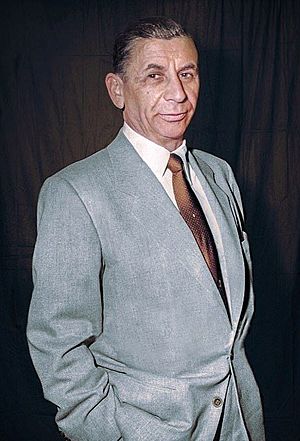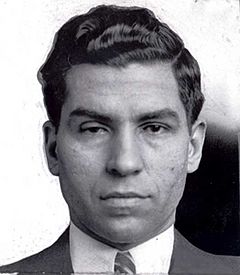Meyer Lansky facts for kids
Quick facts for kids
Meyer Lansky
|
|
|---|---|

Lansky in 1958
|
|
| Born |
Maier Suchowljansky
July 4, 1902 Grodno, Grodno Governorate, Russian Empire
|
| Died | January 15, 1983 (aged 80) Miami Beach, Florida, U.S.
|
| Resting place | Mount Nebo Cemetery, Miami, Florida |
| Nationality | American |
| Known for | Businessman and organized crime figure |
| Spouse(s) |
Anna Citron
(m. 1929; div. 1946)Thelma Schwarz
(m. 1948) |
| Signature | |
Meyer Lansky (born Maier Suchowljansky; July 4, 1902 – January 15, 1983), known as the "Mob's Accountant", was a Russian-American businessman who became a major figure in organized crime in the United States. Along with his associate Charles "Lucky" Luciano, he was a key player in the development of the National Crime Syndicate, a network of criminal organizations.
Lansky was known for creating a worldwide gambling empire. He had ownership in casinos in places like Las Vegas, Cuba, and Miami. He had a strong influence with many powerful groups and was skilled at managing money. The full extent of his activities has been debated, as Lansky himself denied many of the accusations against him.
For nearly 50 years, Lansky was involved in organized crime, but he was never found guilty of a major crime. He was one of the most financially successful crime figures in American history. Before he left Cuba in 1959, it was said he was worth about $20 million. However, when he died in 1983, his family learned that his estate was worth only around $57,000.
Contents
Early Life
Maier Suchowljansky was born on July 4, 1902, in Grodno, in the Russian Empire (now part of Belarus). His family was Polish-Jewish. In 1911, he moved to the United States with his mother and brother. They joined his father in New York City's Lower East Side.
As a boy, Lansky met Benjamin "Bugsy" Siegel, and they became lifelong friends and business partners. During the time of Prohibition, when selling alcohol was illegal, they ran a group known as the Bugs and Meyer Mob.
Lansky also became close friends with Charles "Lucky" Luciano. They met as teenagers when Luciano tried to bully Lansky for money. Lansky stood up to him, and Luciano was so impressed that they formed a lasting partnership.
A Career in Organized Business
Building a Gambling Empire
Luciano wanted to create a national network where different criminal groups could work together and make more money. This idea led to the National Crime Syndicate. Lansky, Luciano, and other leaders organized this network at a conference in Atlantic City in 1929.
By 1936, Lansky had set up successful gambling businesses in Florida and Cuba. His success was based on two main ideas:
- He understood the mathematics of gambling games, which helped him run the casinos very effectively.
- He used his connections to protect his businesses from rivals and the police.
Lansky also made sure his casinos were honest. The games were not rigged, so gamblers knew they had a fair chance to win. This built trust and made his casinos very popular. To keep his money hidden, Lansky was one of the first to use secret bank accounts in other countries like Switzerland.
Helping During World War II
In the 1930s, before the war, Lansky and his associates worked to stop rallies held by pro-Nazi groups in New York. He said he did it because he was Jewish and wanted to stand up for other Jewish people who were suffering in Europe.
During World War II, Lansky helped the U.S. government. In a secret mission called Operation Underworld, the U.S. Navy worked with crime figures to protect the New York Harbor from enemy spies and saboteurs. Lansky used his influence to help guard the docks where warships were being built. In exchange for this help, the government released his friend Lucky Luciano from prison.
Las Vegas and the Flamingo Hotel
In 1946, Lansky persuaded his partners to put his friend Bugsy Siegel in charge of building the Flamingo Hotel in Las Vegas. Lansky became a major investor in the project. However, building the hotel cost much more money than expected, and Siegel's investors grew angry.
A secret meeting was held in Havana, Cuba, to discuss the problem. The other bosses were unhappy with Siegel, but Lansky convinced them to give his friend a second chance. The hotel briefly made a profit, but soon started losing money again. The investors decided they had had enough.
On June 20, 1947, Siegel was killed in Beverly Hills, California. Just 20 minutes later, Lansky's associates walked into the Flamingo and took control of the hotel. The FBI believed Lansky kept a financial interest in the Flamingo for the next 20 years.
Business in Cuba
After World War II, Lansky expanded his business to Cuba. He formed a close friendship and business partnership with Cuba's leader, Fulgencio Batista. In exchange for a share of the profits, Batista gave Lansky and his associates control of Havana's casinos and racetracks.
Batista and Lansky turned Havana into a popular destination for tourists and gamblers. Lansky opened new casinos and hotels, including the famous Habana Riviera. He held a major meeting in Havana in 1946, known as the Havana Conference, where crime leaders from all over America came to plan their future business.
However, this all came to an end in 1959 with the Cuban Revolution. The new leader, Fidel Castro, took power and outlawed gambling. Castro's government took control of all the hotel-casinos on the island. Lansky lost millions of dollars and was forced to flee Cuba.
Later Years and Death
Attempted Move to Israel
In 1970, Lansky moved to Israel to avoid legal problems in the U.S. related to his finances. At the time, Jewish people from anywhere in the world could move to Israel and become citizens under the Law of Return. However, the Israeli government had the right to refuse people with a criminal past. After two years, Lansky was sent back to the United States. He faced a trial in 1973 but was found not guilty.
Final Years
Lansky spent his last ten years living quietly at his home in Miami Beach, Florida. He died of lung cancer on January 15, 1983, at the age of 80.
The Mystery of His Fortune
When Lansky died, he appeared to have very little money. On paper, his estate was worth only about $57,000. At the time, the FBI believed he had over $300 million hidden in secret bank accounts, but they never found the money.
His biographer, Robert Lacey, wrote that Lansky struggled with money in his later years and had trouble paying for medical care for his son. Some believe his wealth and power were greatly exaggerated.
However, others think Lansky was an expert at hiding his money. A journalist who investigated him for years said, "Meyer Lansky doesn't own property. He owns people." In 2010, Lansky's daughter said that her father had given his brother $15 million in the 1970s. The true amount of money Meyer Lansky had will likely never be known.
Meyer Lansky in Popular Culture
Meyer Lansky's life has inspired many characters and stories in movies, television, and books.
In Films
- The character Hyman Roth in The Godfather Part II (1974) is based on Lansky. Lansky even called the actor, Lee Strasberg, to say he did a good job, but added, "You could've made me more sympathetic."
- In the 1983 film Eureka, Joe Pesci plays Mayakofsky, a character like Lansky who wants to expand his gambling business.
- Maximilian "Max" Bercovicz, played by James Woods in Once Upon a Time in America (1984), was inspired by Lansky.
- In the 1990 film Havana, Mark Rydell plays Lansky.
- In the 1991 film Bugsy, about Benjamin Siegel, Lansky is a main character played by Ben Kingsley.
- Patrick Dempsey plays Lansky in the 1991 film Mobsters.
- In the 2002 film Undisputed, a character named Mendy Ripstein says he worked for Meyer Lansky.
- In the 2005 film The Lost City, Dustin Hoffman plays Meyer Lansky.
- In the 2015 film Legend, Meyer Lansky is mentioned often.
- In the 2021 film Lansky, Harvey Keitel plays the older Lansky, and John Magaro plays him when he was younger.
In Television Shows
- In the 1981 NBC miniseries The Gangster Chronicles, the character Michael Lasker, played by Brian Benben, was based on Lansky.
- In the 1993 TV series The Untouchables, Marc Grapey played Lansky in two episodes.
- In the 1999 TV movie Lansky, Richard Dreyfuss stars as Lansky.
- In the HBO series Boardwalk Empire (2010–2014), Meyer Lansky is played by British actor Anatol Yusef.
- In the 2013 TNT series Mob City, Meyer Lansky is played by Patrick Fischler.
- In the 2015 AMC series The Making of the Mob: New York, Meyer Lansky is played by Ian Bell.
In Books
- In the 2010 book New York City Gangland, Meyer Lansky is seen with partners like Benjamin "Bugsy" Siegel.
- In the 1996 novel The Plan by Stephen J. Cannell, Lansky is involved in politics.
- In the 2009 play Lansky by Joseph Bologna, Lansky is played by Mike Burstyn.
- In the book Havana by Stephen Hunter, Lansky is a main character.
- In the 2009 novel If The Dead Rise Not by Philip Kerr, the hero meets Lansky in Havana.
- In the 2009 novel Ride of the Valkyries by Stuart Slade, Meyer Lansky runs Cuba.
- In the 2011 historical fiction novel The Devil Himself by Eric Dezenhall, Meyer Lansky helps with spy operations and war plans.
- Lansky is a supporting character in The Raiders, Harold Robbins' 1995 book.
- In the 2015 novel World Gone By by Dennis Lehane, Lansky is a supporting character and friend.
- The 2016 book Organized Crime in Miami includes photos of Meyer Lansky and his family.
In Music
- Rapper Myalansky got his stage name from Meyer Lansky.
- Jewish-Israeli musician Sagol 59 released a song called "The Ballad Of Meyer Lansky" in 2011. The song tells Lansky's life story.
See also
 In Spanish: Meyer Lansky para niños
In Spanish: Meyer Lansky para niños


